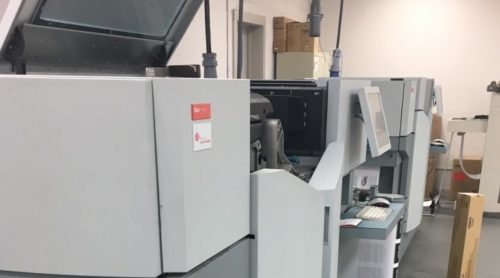Print on Demand Self-Publishing Tips

May, 2019
 Self-Publishing is hot right now.
Self-Publishing is hot right now.
Still, with hundreds of books published each day, it is more vital than ever to make sure your self-published book stands out from the crowd.
You don’t just want to self-publish. You want to self-publish well. With that said, when it comes time to release your final print-ready files to press, you have taken every step to prevent mistakes or incur additional change fees at that time.
Below are some basic tips to follow as you make the journey to becoming a self-published author.
Interior Manuscript
Most (but not all) first time authors start out the writing process putting pen to paper or may start typing away in programs such as Microsoft Word. It is recommended to have a solid idea or decision of the size of the book you would like before beginning this process. Standard published book sizes range from 5.5”x8.5” to 6”x9” to 8”x8” square for children’s books up to 8.5”x11” for educational books and manuals. I say this to emphasize the importance of making your page layout size to the exact size you want your book to be produced at the beginning of the process rather than later.
Next, go through various books you have at home or make a trip to the bookstore to find an interior layout design that you find appealing. Key in on the title page, copyright page, table of contents, headers, and page numbering. These are key aspects to making your book look professional and stand out from the rest. Lastly pay close attention to front matter such as title page, acknowledgment page, etc. and furthermore chapter pages ensuring they are on odd page numbers. You want these pages to be on the right side of your book when opened. Visualization is key.
At this stage, you will want to register for a copyright which gives you tremendous intellectual property protection. Simply go to the website set up by the Library of Congress and purchase the ISBN, the most important identifier of your book.
Editing
Once you have a final manuscript completed to your satisfaction, the editing process begins. While much depends on what level of editing your manuscript has already gone through, for most authors, it is recommended to seek a formal copyedit: you send the manuscript to a professional freelance copyeditor, who will focus on style, grammar, and consistency issues. If you have a friend or family member to do this that is great just be sure you are getting honest and professional feedback.
Cover design
While the manuscript is being copyedited, you can begin on the cover design. Some authors can put together their own cover designs using basic software applications, but since your cover is often the number-one marketing tool for your book, hiring a professional graphic designer is very wise and recommended.
Before you hire a designer for this service, do some research and study bestselling books in your genre. Find a few that you like, and simply jot down a few words explaining why these covers appeal to you. This serves as a starting point you can give to your graphic designer, to help them create an appropriate and marketable cover for your book.
If you haven’t already, you should also finalize the cover content (title, subtitle, and book description, reviews, etc.) that will be used on the front/back cover. This will aid your freelance designer in the design process.
Sometimes authors produce the front cover design first, and they don’t complete the back cover and spine until much closer to the launch date. It’s not possible to design the spine until the exact page count is known, and the page count may not be confirmed until the manuscript is designed and laid out. The cover’s measurements are also affected by the print service you’re using, as well as the type of cover stock and interior paper.
Proofing
As you reach the end of the design process, you’ll have to decide how thorough your proofing process will be. Self-Published Authors often handle their own proofing, while others outsource to professionals. If you think your files are in good shape, and very few errors have been made during the production process, then you might skip hiring someone. However, if you skipped the copyedit, and you’re the only person who has ever looked at the files aside from the designer, then it’s a smart idea to pay for a proofer before publishing.
What’s Next….Invest or Not to Invest?
There are two primary ways to publish and make your book available for sale and utilizing both avenues will maximize your exposure and income stream:
- Print on demand (POD)
- Short to medium run printing
With the advent of Print-on-demand equipment and technology, book printing services can now produce your book one at a time. This is the most popular way to produce print copies of your book because it reduces inventory and furthermore financial risk. When a consumer purchases your book online the book is printed and shipped in a relatively short amount of time.
Pros of print-on-demand
- Costs are held to a minimum, aside from producing printer-ready files
- Your book can be available for sale as a print edition in all the usual online retail outlets such as Amazon and Ingram.
Cons of print-on-demand
- The unit cost is much higher, which may lead to a higher retail price and reduced profits to the author.
- Little to no inventory—or it will be expensive to keep ordering print copies to have handy.
Short to medium run book printing is where you the author takes total control by purchasing the number of books you feel comfortable with for a nominal price and distributing them through your own channel. This option is that Hill Print Solutions specializes in.
Pros of short to medium run printing
- Lower unit cost = more profit
- Higher quality production mainly due to the service having vast printing experience
- You’ll have plenty of print copies in your hand for local speaking engagements, etc. Minimum order runs are typically as low as 50 up to 5,000 books.
Cons of short to medium run printing
- Considerable upfront investment; $500-$2,000 is the likely minimum, which includes the printing and shipping costs.
- Increased risk; what if the books don’t sell or you want to put out a new edition before the old one is sold out?
- You’ll have more books in your possession, which means you must consider warehousing and fulfilling yourself or hire a third party to handle it for you, which then incurs additional costs.
Lastly here are three questions to ask yourself when making this decision:
How and where you plan to sell your book?
If you frequently speak and have opportunities to sell your books at local, regional, or national events, then it makes sense to invest in a short to medium print run. Also consider if you’ll want larger quantities to sell to businesses or organizations, give to clients, etc. I do not recommend investing in a print run because you think bookstores or retail outlets will stock your book. If you do have this opportunity arise, then you can always invest in a print run after you have a purchase order or firm written commitment.
Where are you driving sales?
If you’re driving your customers and readers primarily to online retailers, you can fulfill print orders with less hassle and investment by using POD. If you are controlling your own entity, which we recommend, social media platforms are a tremendous and effective tool to drive sales to your website.
What is your budget?
Investing hard-earned dollars into a short to medium print run can be daunting especially for a first-time author. Therefore, POD might be the best option for you. If you are confident in your product and budgetary means, then short to medium run is best suited. You need to anticipate your appetite for handling the warehousing, fulfillment, and shipping of numerous books unless a third party is handling it for you. Be confident but not cocky. Invest in a short run, experience the ride of controlling your own destiny of being a self-published author without totally breaking the bank and build from there.
Contact Hill Print Solutions for more print on demand self-publishing tips or get an instant quote online. Our specialists can offer the perfect solution for your printing needs.
